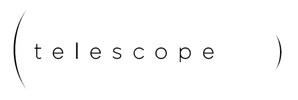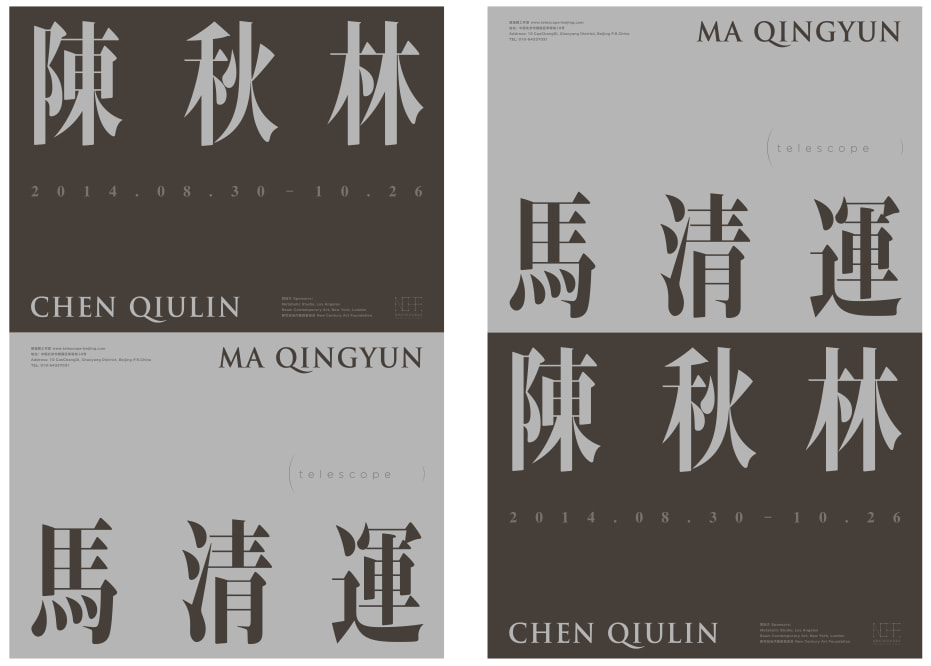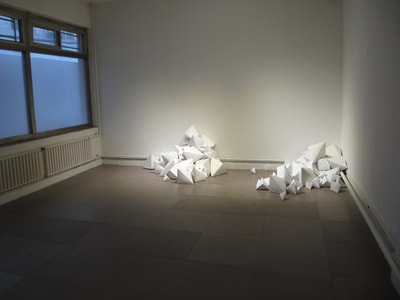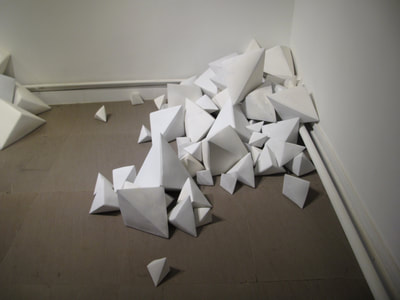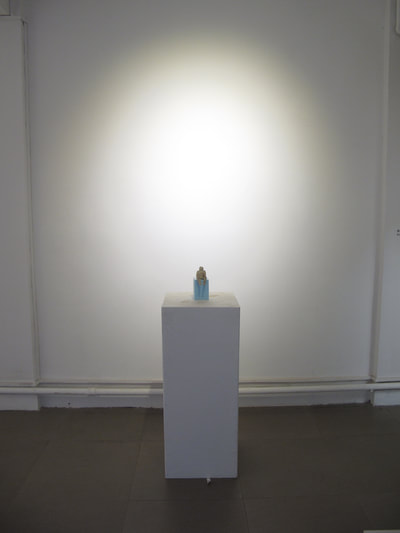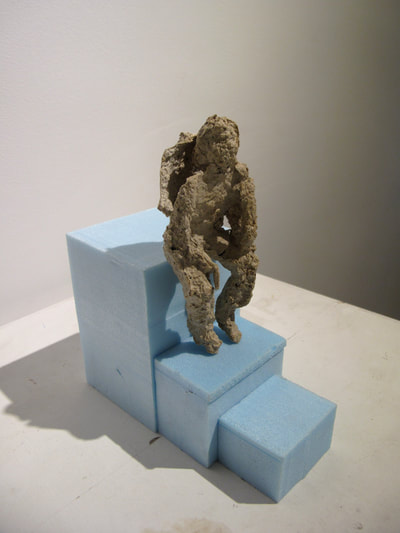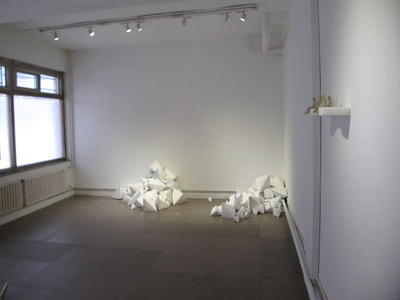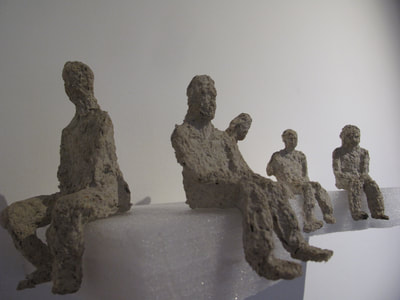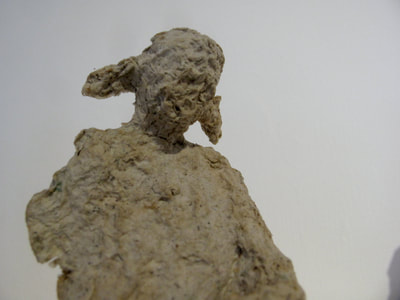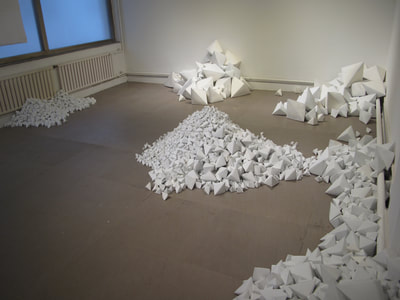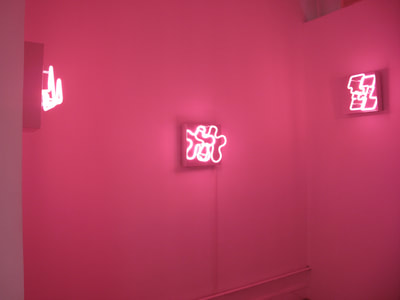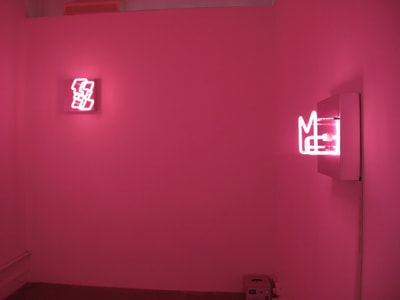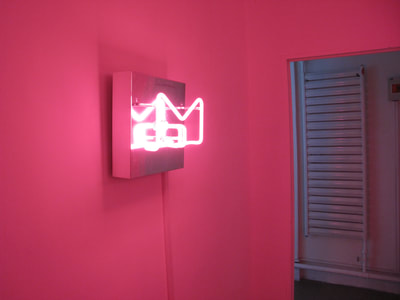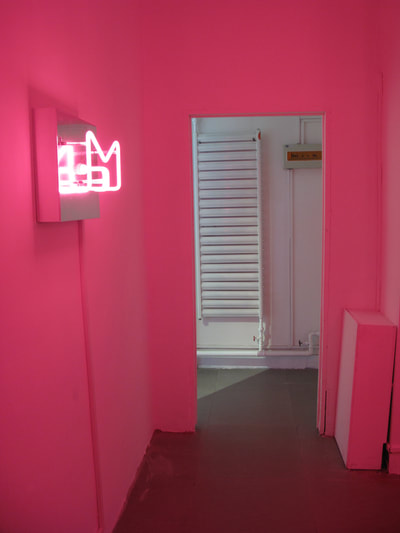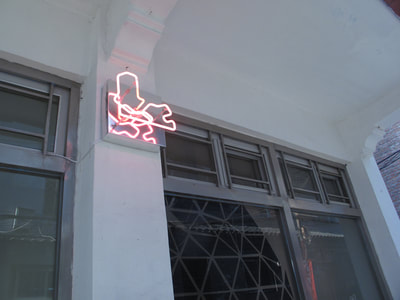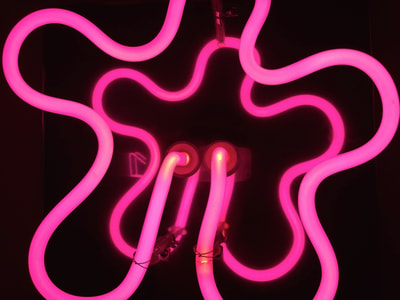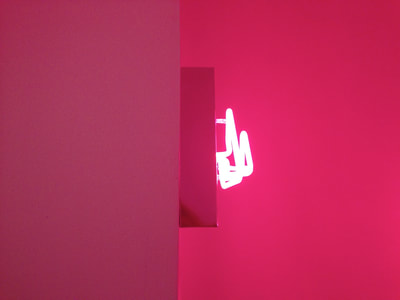陈秋林,马清运 个人展览
AUG. 30 – OCT. 26, 2014
陈秋林
《14235》
自从东汉时期(公元25年至公元220年)的蔡伦极大地改进了造纸术,利用更为廉价的材料使造纸术更易为寻常百姓所触及,折纸和剪纸便在中国社会和文化中具有了重要的仪式性与装饰性角色。在过去10到15年里,电脑、智能手机和电脑游戏以虚拟和数字化的娱乐替代了更为平常、更依赖体力的仪式与设计形式,从而俘虏了中国人的想象力与“间隙时间”。陈秋林过去十年的作品便是有关于记忆与遗失,以及中国政治经济改革对于社会的影响。从目睹她的家乡被拆并没入三峡大坝的洪流,到2008年四川地震造成的严重破坏,她经历了遗失所带来的巨大影响,而她也以各种方式和媒介、通过她自己与他人的个人经历,讲述着这个故事。
陈秋林的最新装置作品《14235》制作于景德镇,1700年来世界上最好的瓷器都是在那里制造出来的。这件作品由14235件白瓷折纸物件组成。陈秋林的装置最初有几百件大小不一的折纸,它们在主展厅的地面上堆成几堆。随着展览的进行,越来越多件折纸将会抵达这里,并被添加到装置当中。就像一片由几何形状的盐结晶体构成的海洋,它们将在空间内漫延,直至上千件白瓷折纸将画廊填满。
2008年初到北京时,我总能注意到折纸物品,它们出现在大街和人行道上、公交车站附近、广场周围,以及人们行走、聚集、坐下或交谈的任何地方。我看着孩子们用折纸玩游戏,他们把叠得很紧实的折纸方块扔到地上,试图将对手的纸弹到空中。这些物件和习惯源自一种同古老过去直接关联的中国民间传统。最近几年我能发现的折纸越来越少了,至少在北京是这样。而今每天看到的,是人们盯着他们的智能手机玩电脑游戏以及看电影,同他们的朋友与周遭世界隔绝开来。
陈秋林所使用的传统材料和方法可能会导致人们将她的叙事错误地解读为仅仅是抽象的或是具有装饰性的。不过,假如你观察过陈秋林早前的作品,再联系到她关于中国乡村的迁移与遗失的主题,便会发现,这些瓷制的折纸可以很容易地使我们想到那上千被遗忘的人,在“进步”和为社会好的名义下,他们被弃置一旁。又或者他们只是个人记忆的碎片,封存在一次性的纸质容器里,并在大量的时间与单调中迷失。她的作品考量了两个不同的世界,这两个世界危险地渐行渐远。这些在地板上挤作一团的卑微形状,如同刚刚落下的雪,覆盖了大量的过错,并指出通往更好明天的道路;那平常的与转瞬即逝的,现在被渲染得雪白而纯净,直至永远。
展览中还纳入了由“混凝纸”制成的小人儿。它们的身形不值一提但范围却很庞大。这些小人儿可怖、幽默、令人惊叹,它们是对于人类的灵魂与身体的极好刻画。它们古老且容貌受损,坐在那里,脚悬荡在空中,端详着那片白色几何田,思索着自身的困境与历史,就像陈秋林家乡的人们那样,他们坐在那里,看着自己的家被拆毁,淹没在水中,或是被自然灾害压成碎片。他们脱水而破碎的身体冻结在一种腐朽的状态里,然而他们的精神,如孩童的那般,是坚韧而能复原的,并且永远年轻。
Solo exhibitions by Chen Qiulin, Ma Qingyun
AUG. 30 – OCT. 26, 2014
Chen Qiulin
14,235
Since Cai Lun greatly improved paper production during the Eastern Han Dynasty, 25-220 AD, by using cheaper materials and making it more accessible to the common people, zhezhi, or paper folding, and Jianzhi, paper cutting, have had important ceremonial and decorative roles in Chinese society and culture. Within the past 10-15 years computers, smartphones, and computer games have taken captive the imaginations and ‘in between time’ time of Chinese people replacing the more common and manual forms of ceremony and design with virtual and digital entertainment. Chen Qiulin’s work for the past 10 years has been about memory and loss and the impact upon society of China’s political and economic reforms. From watching her hometown being dismantled and submerged in the waters of the Three Gorges Dam, to the devastation of the 2008 Sichuan earthquake, she has experienced the reverberations of loss and has been telling this story through her and others personal experiences in various ways and mediums.
Chen’s newest installation work, 14,235, was produced in Jingdezhen, where the finest porcelain in the world has been produced for over 1,700 years. It is made up of 14,235 white porcelain zhezhi objects. Chen’s initial installation is composed of several hundred zhezhi of varying sizes that are in heaps on the floor of the main gallery space. Over the course of the show, more and more pieces will arrive and be added to the installation. Like a sea of geometric salt crystal formations they will seem to grow out into the space until 1000’s of white porcelain zhezhi fill the gallery.
When I first came to China in 2008 I noticed folded paper objects all the time on the streets and sidewalks, around bus stops, plazas, anywhere people walked, congregated, sat, or talked. I watched children play games throwing tightly folded zhezhi squares to the ground trying to flip their opponent’s pieces into the air. These objects and practice come from a Chinese folk tradition with direct links to the ancient past. In the last couple of years I have found less and less zhezhi, at least in Beijing, and now daily watch people gazing into their smartphones playing computer games and watching movies isolated from their friends and the world around them.
Chen’s traditional materials and methods might lead one to misinterpret her narrative as simply abstract or decorative. But if you observe Chen’s earlier works, and make a connection to her themes of displacement and loss in rural China, these porcelain zhezhi could easily remind us of the 1000’s of forgotten who are pushed aside in the name of “progress” and the good of society. Or they could just be the shards of personal memory housed in disposable paper containers and lost in the heap of time and uniformity. Her work views two distinct worlds that are growing dangerously apart. These humble forms huddled together on the floor like new fallen snow cover a multitude of wrongs and point the way to a better day; the common and transient now rendered white and pure, forever.
Also included in the exhibition are small figures made of ‘papier mache.’ They are insignificant in stature but powerful in scope. Terrifying, humorous, breathtaking, they are amazing portraits of the soul and body of mankind. Ancient and disfigured they sit with feet dangling in the air peering out over the white geometric field pondering their plight and history, as people in Chen’s hometown did as they sat and watched their homes being dismantled then drowned in water, or crushed by natural disasters. Their dried and broken bodies are in a frozen state of decay but their spirits, like children, are resilient and ever young.
AUG. 30 – OCT. 26, 2014
陈秋林
《14235》
自从东汉时期(公元25年至公元220年)的蔡伦极大地改进了造纸术,利用更为廉价的材料使造纸术更易为寻常百姓所触及,折纸和剪纸便在中国社会和文化中具有了重要的仪式性与装饰性角色。在过去10到15年里,电脑、智能手机和电脑游戏以虚拟和数字化的娱乐替代了更为平常、更依赖体力的仪式与设计形式,从而俘虏了中国人的想象力与“间隙时间”。陈秋林过去十年的作品便是有关于记忆与遗失,以及中国政治经济改革对于社会的影响。从目睹她的家乡被拆并没入三峡大坝的洪流,到2008年四川地震造成的严重破坏,她经历了遗失所带来的巨大影响,而她也以各种方式和媒介、通过她自己与他人的个人经历,讲述着这个故事。
陈秋林的最新装置作品《14235》制作于景德镇,1700年来世界上最好的瓷器都是在那里制造出来的。这件作品由14235件白瓷折纸物件组成。陈秋林的装置最初有几百件大小不一的折纸,它们在主展厅的地面上堆成几堆。随着展览的进行,越来越多件折纸将会抵达这里,并被添加到装置当中。就像一片由几何形状的盐结晶体构成的海洋,它们将在空间内漫延,直至上千件白瓷折纸将画廊填满。
2008年初到北京时,我总能注意到折纸物品,它们出现在大街和人行道上、公交车站附近、广场周围,以及人们行走、聚集、坐下或交谈的任何地方。我看着孩子们用折纸玩游戏,他们把叠得很紧实的折纸方块扔到地上,试图将对手的纸弹到空中。这些物件和习惯源自一种同古老过去直接关联的中国民间传统。最近几年我能发现的折纸越来越少了,至少在北京是这样。而今每天看到的,是人们盯着他们的智能手机玩电脑游戏以及看电影,同他们的朋友与周遭世界隔绝开来。
陈秋林所使用的传统材料和方法可能会导致人们将她的叙事错误地解读为仅仅是抽象的或是具有装饰性的。不过,假如你观察过陈秋林早前的作品,再联系到她关于中国乡村的迁移与遗失的主题,便会发现,这些瓷制的折纸可以很容易地使我们想到那上千被遗忘的人,在“进步”和为社会好的名义下,他们被弃置一旁。又或者他们只是个人记忆的碎片,封存在一次性的纸质容器里,并在大量的时间与单调中迷失。她的作品考量了两个不同的世界,这两个世界危险地渐行渐远。这些在地板上挤作一团的卑微形状,如同刚刚落下的雪,覆盖了大量的过错,并指出通往更好明天的道路;那平常的与转瞬即逝的,现在被渲染得雪白而纯净,直至永远。
展览中还纳入了由“混凝纸”制成的小人儿。它们的身形不值一提但范围却很庞大。这些小人儿可怖、幽默、令人惊叹,它们是对于人类的灵魂与身体的极好刻画。它们古老且容貌受损,坐在那里,脚悬荡在空中,端详着那片白色几何田,思索着自身的困境与历史,就像陈秋林家乡的人们那样,他们坐在那里,看着自己的家被拆毁,淹没在水中,或是被自然灾害压成碎片。他们脱水而破碎的身体冻结在一种腐朽的状态里,然而他们的精神,如孩童的那般,是坚韧而能复原的,并且永远年轻。
Solo exhibitions by Chen Qiulin, Ma Qingyun
AUG. 30 – OCT. 26, 2014
Chen Qiulin
14,235
Since Cai Lun greatly improved paper production during the Eastern Han Dynasty, 25-220 AD, by using cheaper materials and making it more accessible to the common people, zhezhi, or paper folding, and Jianzhi, paper cutting, have had important ceremonial and decorative roles in Chinese society and culture. Within the past 10-15 years computers, smartphones, and computer games have taken captive the imaginations and ‘in between time’ time of Chinese people replacing the more common and manual forms of ceremony and design with virtual and digital entertainment. Chen Qiulin’s work for the past 10 years has been about memory and loss and the impact upon society of China’s political and economic reforms. From watching her hometown being dismantled and submerged in the waters of the Three Gorges Dam, to the devastation of the 2008 Sichuan earthquake, she has experienced the reverberations of loss and has been telling this story through her and others personal experiences in various ways and mediums.
Chen’s newest installation work, 14,235, was produced in Jingdezhen, where the finest porcelain in the world has been produced for over 1,700 years. It is made up of 14,235 white porcelain zhezhi objects. Chen’s initial installation is composed of several hundred zhezhi of varying sizes that are in heaps on the floor of the main gallery space. Over the course of the show, more and more pieces will arrive and be added to the installation. Like a sea of geometric salt crystal formations they will seem to grow out into the space until 1000’s of white porcelain zhezhi fill the gallery.
When I first came to China in 2008 I noticed folded paper objects all the time on the streets and sidewalks, around bus stops, plazas, anywhere people walked, congregated, sat, or talked. I watched children play games throwing tightly folded zhezhi squares to the ground trying to flip their opponent’s pieces into the air. These objects and practice come from a Chinese folk tradition with direct links to the ancient past. In the last couple of years I have found less and less zhezhi, at least in Beijing, and now daily watch people gazing into their smartphones playing computer games and watching movies isolated from their friends and the world around them.
Chen’s traditional materials and methods might lead one to misinterpret her narrative as simply abstract or decorative. But if you observe Chen’s earlier works, and make a connection to her themes of displacement and loss in rural China, these porcelain zhezhi could easily remind us of the 1000’s of forgotten who are pushed aside in the name of “progress” and the good of society. Or they could just be the shards of personal memory housed in disposable paper containers and lost in the heap of time and uniformity. Her work views two distinct worlds that are growing dangerously apart. These humble forms huddled together on the floor like new fallen snow cover a multitude of wrongs and point the way to a better day; the common and transient now rendered white and pure, forever.
Also included in the exhibition are small figures made of ‘papier mache.’ They are insignificant in stature but powerful in scope. Terrifying, humorous, breathtaking, they are amazing portraits of the soul and body of mankind. Ancient and disfigured they sit with feet dangling in the air peering out over the white geometric field pondering their plight and history, as people in Chen’s hometown did as they sat and watched their homes being dismantled then drowned in water, or crushed by natural disasters. Their dried and broken bodies are in a frozen state of decay but their spirits, like children, are resilient and ever young.
installation view_CHEN Qiulin
陈秋林,马清运 个人展览
AUG. 30 – OCT. 26, 2014
马清运
《淡城市》
马清运被认为是世界上最有影响力的设计师和建筑师之一,他展出的新雕塑作品由粉色霓虹组成,题为《淡城市》(Lite-urbanism)。通过将形式与功能简化为微弱霓虹灯光下单纯的书法线条,马清运暗示了一种新的城市主义。这些作品既“异想天开”又“格格不入”,它们是基于马清运那些未建起的建筑项目。作品以关于建筑物的想法而非建筑物本身为基础,这或许正恰如其分,因为不管是在马清运的哲学中还是总体说来在中国文化中,无常都是极为重要的概念。马清运陈述道,孔子的话基本上是在说“去也。去也,”生命中的所有皆是无常,而生命本身是流动的,处于不断的变化当中,你无法抓紧任何东西。建筑的基础是强度与长期的稳定性,但在东方思想中,人们的理解是“一切”都会改变。西方迷恋于保存他们已经建立起来的所有,而东方则容许衰败与终极替换的发生。马清运提出这样一个问题,我们是否应当考虑“临时的建筑物而非永恒的纪念碑?”对马清运而言,从庞大的城市规划和大规模建筑项目中迁移出来,进入草场地一个由旧按摩店改成的小型非盈利艺术空间,并且从强力的建筑材料转向脆弱的、填满粉色乙醚的玻璃管,是对于他基本创作哲学的一种证明。马清运说,“最终,对我而言,建筑不是关于建筑物的,它实际上是关于创造一切,其环境可以是任何事物或一切事物;甚至一段谈话,”或是空间中一道昙花一现的玻璃线。
在望远镜,马清运安装了几个一尺见方的铝盒霓虹标示牌。它们尺寸很小,光线微弱稀薄,但火热的粉色光辉笼罩着从地面到天花板的整个房间,并弥漫于空气中。它们抽象、灵活,且具有“迅捷”的力量,马清运说道。走进这个房间,你会很容易忘记呼吸以及对地点与时间的概念,因为你忽然之间被粉色光线包围了。那种感觉是强烈、神秘而难以形容的。它具有一种奇怪的诱惑力,像塞壬,一位令人难以抗拒的美人,却陌生,可能还很危险。在这个新地方,身份受到挑战,界线与传统被打破。这是一个你不知道接下来会发生什么的地方。《淡城市》代表了一种新的城市,它可以依据所需打开和关闭,快速适应城市里变化着的需求和欲望。它是一种无实质、无阻碍但却无所不在的城市。在望远镜展出的《淡城市》只是一个起点,马清运对于未来的展望是用这些光线建造一整个城市。“一个充满永不建造出来的项目的城市,一个充盈着永远流动的能量的空间,无论何时,无论何地,无论如何,”马清运如此宣明。《淡城市》的蔓生物正朝你走来。
Solo exhibitions by Chen Qiulin, Ma Qingyun
AUG. 30 – OCT. 26, 2014
Ma Qingyun
Lite-urbanism
Ma Qingyun, considered to be one of the most influential designers and architects in the world, presents new sculptures of pink neon entitled Lite-urbanism. Ma suggests a new urbanism by reducing form and function to simple calligraphic lines in the fragile light of neon. These works, “whimsical” yet “alien,” are based on Ma’s un-built architectural projects. Perhaps it is fitting that this work is based on ideas for buildings and not the buildings themselves, as impermanence is extremely important in Ma’s philosophy and in Chinese culture in general. Ma states that Confucius basically said, “It’s gone. It’s gone,” that all in life is impermanent and that life itself is a flow, in flux, you cannot hold onto anything. Architecture is based on strength and long-term stability, but in Eastern thought it is understood that ‘everything’ changes. The west is obsessed with preservation of all they have built, while the east allows for decay and ultimately replacement. Ma asks the question, should we consider “temporary buildings instead of eternal monuments?” For Ma, to move from massive city planning and large scale building projects to a small non profit art space in an old massage parlor in Cao Chang Di, and from powerful architectural materials to fragile tubes of glass filled with pink ether is a testament to his basic creative philosophy. Ma states, “In the end, for me, architecture is not about buildings, it is actually about creating everything, that environment can be anything or everything; a conversation even,” or an ephemeral line of glass in space.
In Telescope Ma has installed several one-foot square aluminum box neon signs. They are small in scale, the lights are fragile and thin, but their hot pink glow dominates the room from floor to ceiling and fills the air. They are abstract, adaptable, and have the power of “swiftness” states Ma. Stepping into the room it is easy to lose your breath and sense of place and time as you are suddenly enveloped in pink light. The sensation is profound, mysterious, and indescribable. It has the strange allure of a siren, a beauty that is irresistible, but alien and possibly dangerous. This is a new place where identities are challenged and boundaries and traditions are broken. A place where you don’t know what comes next? Lite urbanism represents a new city, one that can be turned on and off as needed, adapts swiftly to the changing needs and desires of the city. It is a new non-substantial, non-obstructive, yet pervasive city. Lite Urbanism at Telescope is just the beginning to Ma’s vision of the future, to make an entire city of these lights. “A city of never built projects, a space of ever flowing energy, whenever, wherever and however, “ proclaims Ma. Lite urbanism sprawl is headed your way.
AUG. 30 – OCT. 26, 2014
马清运
《淡城市》
马清运被认为是世界上最有影响力的设计师和建筑师之一,他展出的新雕塑作品由粉色霓虹组成,题为《淡城市》(Lite-urbanism)。通过将形式与功能简化为微弱霓虹灯光下单纯的书法线条,马清运暗示了一种新的城市主义。这些作品既“异想天开”又“格格不入”,它们是基于马清运那些未建起的建筑项目。作品以关于建筑物的想法而非建筑物本身为基础,这或许正恰如其分,因为不管是在马清运的哲学中还是总体说来在中国文化中,无常都是极为重要的概念。马清运陈述道,孔子的话基本上是在说“去也。去也,”生命中的所有皆是无常,而生命本身是流动的,处于不断的变化当中,你无法抓紧任何东西。建筑的基础是强度与长期的稳定性,但在东方思想中,人们的理解是“一切”都会改变。西方迷恋于保存他们已经建立起来的所有,而东方则容许衰败与终极替换的发生。马清运提出这样一个问题,我们是否应当考虑“临时的建筑物而非永恒的纪念碑?”对马清运而言,从庞大的城市规划和大规模建筑项目中迁移出来,进入草场地一个由旧按摩店改成的小型非盈利艺术空间,并且从强力的建筑材料转向脆弱的、填满粉色乙醚的玻璃管,是对于他基本创作哲学的一种证明。马清运说,“最终,对我而言,建筑不是关于建筑物的,它实际上是关于创造一切,其环境可以是任何事物或一切事物;甚至一段谈话,”或是空间中一道昙花一现的玻璃线。
在望远镜,马清运安装了几个一尺见方的铝盒霓虹标示牌。它们尺寸很小,光线微弱稀薄,但火热的粉色光辉笼罩着从地面到天花板的整个房间,并弥漫于空气中。它们抽象、灵活,且具有“迅捷”的力量,马清运说道。走进这个房间,你会很容易忘记呼吸以及对地点与时间的概念,因为你忽然之间被粉色光线包围了。那种感觉是强烈、神秘而难以形容的。它具有一种奇怪的诱惑力,像塞壬,一位令人难以抗拒的美人,却陌生,可能还很危险。在这个新地方,身份受到挑战,界线与传统被打破。这是一个你不知道接下来会发生什么的地方。《淡城市》代表了一种新的城市,它可以依据所需打开和关闭,快速适应城市里变化着的需求和欲望。它是一种无实质、无阻碍但却无所不在的城市。在望远镜展出的《淡城市》只是一个起点,马清运对于未来的展望是用这些光线建造一整个城市。“一个充满永不建造出来的项目的城市,一个充盈着永远流动的能量的空间,无论何时,无论何地,无论如何,”马清运如此宣明。《淡城市》的蔓生物正朝你走来。
Solo exhibitions by Chen Qiulin, Ma Qingyun
AUG. 30 – OCT. 26, 2014
Ma Qingyun
Lite-urbanism
Ma Qingyun, considered to be one of the most influential designers and architects in the world, presents new sculptures of pink neon entitled Lite-urbanism. Ma suggests a new urbanism by reducing form and function to simple calligraphic lines in the fragile light of neon. These works, “whimsical” yet “alien,” are based on Ma’s un-built architectural projects. Perhaps it is fitting that this work is based on ideas for buildings and not the buildings themselves, as impermanence is extremely important in Ma’s philosophy and in Chinese culture in general. Ma states that Confucius basically said, “It’s gone. It’s gone,” that all in life is impermanent and that life itself is a flow, in flux, you cannot hold onto anything. Architecture is based on strength and long-term stability, but in Eastern thought it is understood that ‘everything’ changes. The west is obsessed with preservation of all they have built, while the east allows for decay and ultimately replacement. Ma asks the question, should we consider “temporary buildings instead of eternal monuments?” For Ma, to move from massive city planning and large scale building projects to a small non profit art space in an old massage parlor in Cao Chang Di, and from powerful architectural materials to fragile tubes of glass filled with pink ether is a testament to his basic creative philosophy. Ma states, “In the end, for me, architecture is not about buildings, it is actually about creating everything, that environment can be anything or everything; a conversation even,” or an ephemeral line of glass in space.
In Telescope Ma has installed several one-foot square aluminum box neon signs. They are small in scale, the lights are fragile and thin, but their hot pink glow dominates the room from floor to ceiling and fills the air. They are abstract, adaptable, and have the power of “swiftness” states Ma. Stepping into the room it is easy to lose your breath and sense of place and time as you are suddenly enveloped in pink light. The sensation is profound, mysterious, and indescribable. It has the strange allure of a siren, a beauty that is irresistible, but alien and possibly dangerous. This is a new place where identities are challenged and boundaries and traditions are broken. A place where you don’t know what comes next? Lite urbanism represents a new city, one that can be turned on and off as needed, adapts swiftly to the changing needs and desires of the city. It is a new non-substantial, non-obstructive, yet pervasive city. Lite Urbanism at Telescope is just the beginning to Ma’s vision of the future, to make an entire city of these lights. “A city of never built projects, a space of ever flowing energy, whenever, wherever and however, “ proclaims Ma. Lite urbanism sprawl is headed your way.
